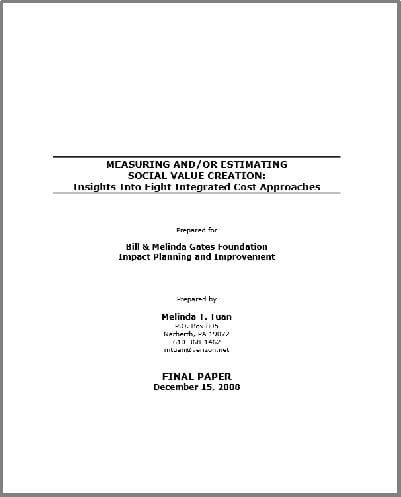 If we focus long enough on a topic and attempt to uncover what is really going on, themes should emerge in the midst of differing perspectives. Melinda Tuan takes the topic of evaluation right up to that point, one at which we should stop and reflect. In the post just prior to this one, the responsibility for better evaluation was placed squarely on people, not technology. Continuing that line of thought (professional responsiblity), Melinda puts the question on a persistent theme across the sector: “Why is the capital structure for organizational funding not suited for true capacity-building?” Read on for her comment (based on a recent listening tour) and let us know what you think – whether you agree that this is the case, or if you have more to add to the discussion in a way that can help move us from conversation into a better way of working and supporting frontline organizations.
If we focus long enough on a topic and attempt to uncover what is really going on, themes should emerge in the midst of differing perspectives. Melinda Tuan takes the topic of evaluation right up to that point, one at which we should stop and reflect. In the post just prior to this one, the responsibility for better evaluation was placed squarely on people, not technology. Continuing that line of thought (professional responsiblity), Melinda puts the question on a persistent theme across the sector: “Why is the capital structure for organizational funding not suited for true capacity-building?” Read on for her comment (based on a recent listening tour) and let us know what you think – whether you agree that this is the case, or if you have more to add to the discussion in a way that can help move us from conversation into a better way of working and supporting frontline organizations.
…
In an ideal world, nonprofit organizations and NGOs are able to easily and comprehensively assess the impact of their work on the beneficiaries of their programs and services. They can not only count the number of people served or acres of environment saved, but also measure the positive change achieved by their programs over time; demonstrate the efficacy of their work compared to other approaches; and calculate the cost-effectiveness of their efforts.
In an ideal world, donors and investors are able to easily ascertain the projected and actual impact of their grantees’ work. They can not only compare and contrast the social value created by individual organizations but also aggregate impact across portfolios of grantees. Using evaluation data, they can coordinate their efforts with other funders to make sure they are supporting the right organizations, with the best strategies, and the highest fidelity implementation to achieve lasting social change.
In an ideal world, high quality data collection, accurate data analyses, and insightful interpretations which together sum up to excellent evaluation practice are widespread throughout the social sector.
We do not live in an ideal world.
As discussed previously in a paper commissioned by the Bill & Melinda Gates Foundation (below), there are numerous barriers to achieving widespread high quality evaluation in the social sector. These barriers include, perhaps most significantly, a lack of high quality data on impacts, outcomes, outputs, and costs. In a discipline driven by data, we are missing the fundamental units of analyses necessary to evaluate our collective work. This lack of data is not due to disinterest on the part of nonprofit organizations; rather a lack of capacity to collect, analyze and report on the impact of their work.
These barriers include, perhaps most significantly, a lack of high quality data on impacts, outcomes, outputs, and costs. In a discipline driven by data, we are missing the fundamental units of analyses necessary to evaluate our collective work. This lack of data is not due to disinterest on the part of nonprofit organizations; rather a lack of capacity to collect, analyze and report on the impact of their work.
I recently completed a listening tour with nonprofit CEOs across the country on behalf of Grantmakers for Effective Organizations (GEO). I heard firsthand from dozens of nonprofit leaders about the day-to-day challenges they face in building their organizational capacity to execute on their missions. While funders and investors may be thinking about randomized control trials and the possibilities for “big data” to evaluate nonprofit performance; many nonprofits are struggling to keep the lights on as they run their programs.
One executive director described her reality: “My biggest challenge is finding time for small things; like finding a better IT person so when our computers go down, it doesn’t take a week to fix the problem.” Additionally, many nonprofit leaders “feel really challenged to do something like build an evaluation system where I don’t have a whole lot of experience or expertise. Even with the help of consultants, I feel personally challenged to feel capable of doing that” shared another executive director.
The fundamental problem underlying these capacity constraints is how capital flows in the nonprofit sector.
I recently partnered with the entrepreneur/owners of the Evergreen Lodge to raise capital for a second social purpose destination resort in Yosemite to provide job training and employment for at-risk young adults from the San Francisco Bay Area. Building on the strength of the financial returns and positive stories about trainee/employees’ lives changed at the Evergreen Lodge, we were able to raise over $5.5 million from mission-aligned impact investors over a six-month period for the development of Rush Creek Lodge. None of this capital was restricted in its use.
This example stands in stark contrast to the experience of nonprofit entrepreneurs/leaders across the country who struggle to piece together funding on an annual basis from sometimes dozens of funding sources. This capital is almost always restricted to particular uses and is predominantly for program only, not for “overhead.” While a growing body of funders provides capacity-building grants to nonprofit organizations, these grants targeted at building infrastructure often come with restrictions and limited timeframes.
During the listening tour, a couple of executive directors pointed out that “capacity-building grants usually pay for the consultant, but not the staff time to work with the consultant;” and “funders build our capacity and then what? The funders are going to walk away and we have to be able to sustain whatever they helped us build. A lot of the challenge with capacity building is the question of how we’re going to sustain the work after the funders are done helping us.” The prevailing practice of providing short-term, restricted grants limits nonprofit organizations’ ability to successfully invest in the necessary infrastructure to deliver high quality programs, much less evaluate the efficacy of those programs.
If we hope to accurately evaluate the work of nonprofit organizations, we need to change the way capital flows in the sector. Funders must provide long-term, general operating support to their grantees combined with flexible, multi-year capacity-building grants – to invest in the infrastructure of nonprofit organizations to build their data collection, analysis and interpretation capacity in order to engage in high quality evaluation of their work; and also to keep the lights on.
